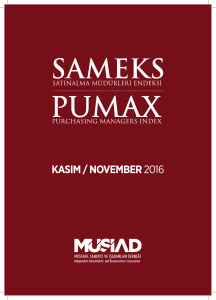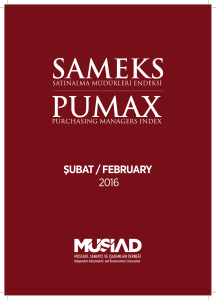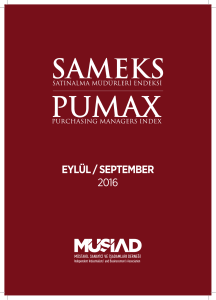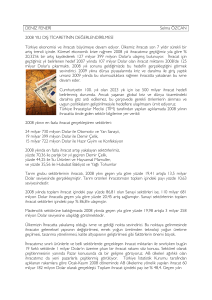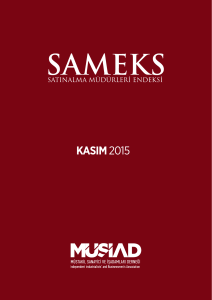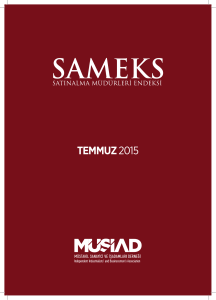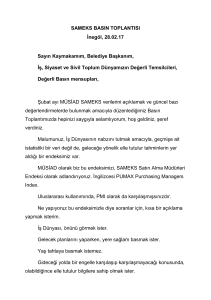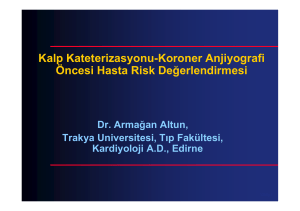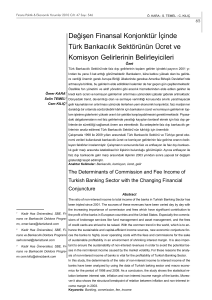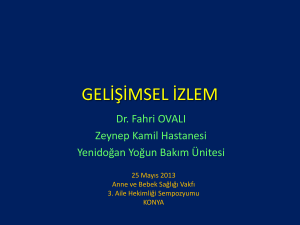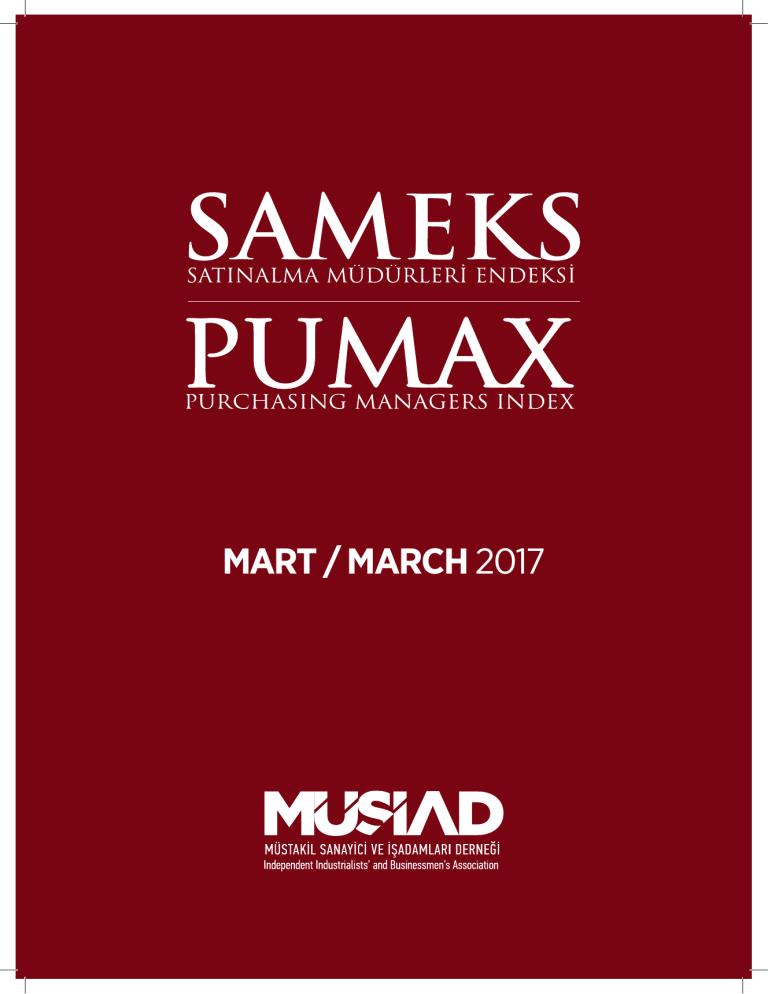
MART / MARCH 2017
SAMEKS
Mevsim ve takvim etkisinden arındırılmış SAMEKS Bileşik Endeksi, bir önceki aya göre 1,3
puan azalmasına karşın Mart ayındaki 50,1
puanlık değeriyle ekonomik aktivitedeki canlılığın sürdüğüne işaret etmiştir. Endekste
gözlenen bu azalışta, hizmet sektörünün önceki aya göre 2,8 puan düşüş kaydederek 50,0
seviyesine gerilemesi etkili olurken, 1,0 puan
yükselen sanayi sektörü ise 51,1 puanla olumlu
görünümünü sürdürmüştür.
Bu dönemde sanayi sektörüne yönelik yeni siparişlerin artması girdi alımları ve üretimi olumlu yönde etkilerken; gerçekleşen üretim artışı
da istihdamı desteklemiştir. Hizmet sektöründe
ise girdi alımlarında gözlenen hız kaybı iş hac-
4
PUMAX
minde gerilemeye neden olmuş; bunun neticesinde de stoktan tüketim hızlanırken istihdam
gerilemiştir.
Mevsim ve takvim etkisinden arındırılmış SAMEKS Bileşik Endeksi’nin 50,1 puanlık değeri
2017 yılı Mart ayına ilişkin ekonomik aktivitenin
canlılığına işaret ederken, böylece Şubat ayında başlayan olumlu görünüm sürmüştür.
1. Sanayi Sektörü SAMEKS Endeksi
Mevsim ve takvim etkisinden arındırılmış SAMEKS Sanayi Endeksi, 2017 yılı Mart ayında, bir
önceki aya göre 1,0 puan artarak 51,1 seviyesine yükselmiştir. Üretim (1,6 puan), Yeni Sipariş
(2,3 puan), Satın Alım (2,9 puan) ve İstihdam
(1,7 puan) alt endekslerinde gözlenen artışlar,
Seasonally adjusted PUMAX Composite Index
pointed to the ongoing vitality in economic
activities with a value of 50.1 points in March,
in spite of a 1.3 points drop compared to the
previous month. The service sector’s regression to 50.0 level with a 2.8 point-decrease
compared to the previous month was effective in the Index decline, whereas the industrial sector maintains its positive outlook at 51.1
points with a 1.0 point-rise.
In this period, the increase in new orders in the
industry sector positively affected inputs purchases and production, while the increase in
production supported employment. The observed momentum loss in inputs purchases in
the service sector caused a decrease in business
volume, resulting in a regression in employment
and acceleration in stock consumption.
The 50.1 point-value of the seasonally adjusted PUMAX Composite Index demonstrates the
vitality of economic activities in March 2017,
which perpetuates the positive outlook started
in February.
1. PUMAX Industry Sector Index
Seasonally adjusted PUMAX Industry Index
rose by 1.0 point in March 2017 compared to the
previous month and reached 51.1 points. The
increases observed in the sub-indexes of Production (1.6 points), New Orders (2.3 points),
Purchasing (2.9 points) and Employment (1.7
points) were decisive in the momentum gained
in the industry sector.
5
sanayi sektörünün hızlanmasında belirleyici olmuştur.
Mart ayında yeni siparişlerde önceki aya göre
gözlenen artışlar firmaların girdi alımlarını
olumlu yönde etkilerken, buna bağlı olarak üretim artış kaydetmiştir. Sektöre ait istihdam ise,
49,6 puanda kalmasına karşın, önceki aya göre
1,7 puan artarak toparlanma sinyali vermiştir.
Böylece mevsim ve takvim etkisinden arındırılmış SAMEKS Sanayi Endeksi, Ocak ve Şubat
dönemlerindeki olumlu görünümünü Mart ayında da sürdürmüş ve 51,1 puanlık değeriyle sektördeki canlılığa işaret etmiştir. Yılın ilk çeyreğini 50,9 puan ortalamasıyla kapatan SAMEKS
Sanayi Endeksi, bu döneme ilişkin büyüme rakamları için pozitif bir tablo sunmaktadır.
a. Üretim
Sanayi sektörüne ait Üretim alt endeksi, Mart
ayında bir önceki aya göre 1,6 puan artarak 51,4
seviyesine yükselmiştir. Üretiminde gözlenen
bu artışta yeni siparişler ve girdi alımlarında
gözlenen ivmelenme belirleyici olmuştur.
b. Yeni Sipariş
Sanayi sektörüne ait Yeni Sipariş alt endeksi,
Mart ayında bir önceki aya göre 2,3 puan artarak 49,9 seviyesine yükselmiştir. Yeni Siparişlerde gözlenen bu artış, sanayi sektöründeki görülen canlanmanın başlıca göstergesi olmuştur.
c. Satın Alım
Sanayi sektörüne ait Satın Alım alt endeksi,
Mart ayında bir önceki aya göre 2,9 puan artarak 59,9 seviyesine yükselmiştir. Girdi alımlarındaki artışın hızlanarak sürmesi, üretimdeki
artışın önümüzdeki dönemlerde de devam edeceğine işaret etmektedir.
d. Nihai Mal Stoku
Sanayi sektörüne ait Nihai Mal Stoku alt endeksi, Mart ayında bir önceki aya göre 2,8 puan
azalarak 49,0 seviyesine gerilemiştir. Bu azalış,
firmaların yeni siparişlere cevap verirken öncelikli olarak mevcut stoklarını tüketme yolunu
tercih ettiklerini göstermektedir.
e. Tedarikçilerin Teslimat Süresi
Sanayi sektörüne ait Tedarikçilerin Teslimat
Süresi alt endeksi, Mart ayında bir önceki aya
6
In March, the increase observed in new orders
compared to the previous month positively affected firms’ inputs purchases, which led to an
increase in production. While remaining at 49.6
points, the sectoral employment still indicated
a recovery with an increase of 1.7 points compared to the previous month.
Therefore, seasonally adjusted PUMAX Industry maintained its positive outlook observed in
January and February also in March and pointed to the sectoral vitality with a value of 51.1
points. Finishing the first quarter of the year
with an average of 50.9 points, PUMAX Industry Index presents a positive picture in terms of
growth numbers relating to this period.
a. Production
The Production sub-index of the industry sector rose by 1.6 points in March compared to the
previous month to reach 51.4 points. The momentum observed in new orders and inputs
purchases were decisive in the increase in production.
b. New Orders
The New Orders sub-index of the industry sector rose by 2.3 points in March compared to the
previous month to reach 49.9 points. This increase observed in New Orders was the main
indicator of the revitalization observed in the
industry sector.
c. Purchasing
The Purchasing sub-index of the industry sector rose by 2.9 points in March compared to the
previous month to reach 59.9 points. The fast
increase in Inputs purchases indicates that production increase will also continue in the next
periods.
d. Final Good Inventory
The Final Good Inventory sub-index of the industry sector declined by 2.8 points to 49.0 level in March compared to the previous month.
This decline demonstrates that the firms preferred consuming primarily the current stocks
in response to new orders.
e. Suppliers’ Delivery Time
The Suppliers’ Delivery Time sub-index of the
industry sector declined by 1.6 points to 48.1
7
karşın 57,1 seviyesinde gerçekleşen Satın Alım
alt endeksi, firmaların sektöre olan güvenini
sürdüğüne işaret etmektedir. İş hacminin önceki aya göre azalması sektöre yönelik istihdamı
olumsuz etkilerken, firmalar bu dönemde ağırlıklı olarak mevcut stoklarını tüketme yoluna
gitmişlerdir.
göre 1,6 puan azalarak 48,1 seviyesine gerilemiştir. Mart ayında katılımcıların %75’i teslimat
sürelerinde önemli bir değişim olmadığını ifade
etmiştir.
f. İstihdam
Sanayi sektörüne ait İstihdam alt endeksi, Mart
ayında bir önceki aya göre 1,7 puan artarak 49,6
seviyesine yükselmiştir. Yeni siparişler ve girdi
alımlarının artışıyla hızlanan üretim, bu dönemde sektöre yönelik istihdam artışını olumlu etkilemiştir.
2. Hizmet Sektörü SAMEKS Endeksi
Mevsim ve takvim etkisinden arındırılmış SAMEKS Hizmet Endeksi; 2016 yılı Mart ayında, bir
önceki aya göre 2,8 puan azalarak 50,0 değerine gerilemiştir. İş Hacmi (2,1 puan), Satın Alım
(3,8 puan), ve İstihdam (4,7 puan) alt endekslerinde gerçekleşen azalışlar, hizmet sektöründe
gözlenen yavaşlamanın en önemli belirleyicileri
olmuştur.
Girdi alımlarında Eylül 2016 döneminde başlayan olumlu görünüm Mart ayında da devam
etmiş; önceki aya göre 3,8 puan azalmasına
8
Önceki aya göre 2,8 puan azalmış olmasına karşın; mevsim ve takvim etkisinden arındırılmış
SAMEKS Hizmet Endeksi’nin 50,0 seviyesinde
gerçekleşmesi, sektöre yönelik olumlu görünümün sürdüğüne işaret etmektedir.
a. İş Hacmi
Hizmet sektörüne ait İş Hacmi alt endeksi, Mart
ayında bir önceki aya göre 2,1 puan azalarak 47,7
seviyesine gerilemiştir. Girdi alımlarında pozitif
görünümün sürmesi, iş hacminin önümüzdeki
dönemde artışa geçeceğine işaret etmektedir.
b. Satın Alım
Hizmet sektörüne ait Satın Alım alt endeksi,
Mart ayında bir önceki aya göre 3,8 puan azalarak 57,1 seviyesine gerilemiştir. İş hacminde
gözlenen daralmaya rağmen girdi alımlarının
sub-index was realized at 57.1 level, indicating
the firms’ ongoing trust in the sector. Decline
of business volume compared to the previous
month negatively affected employment, while
firms began to mainly consume their current
stocks.
Despite the 2.8 point-drop compared to the
level in March compared to the previous month. previous month, seasonally adjusted PUMAX
In March, 75% of the participants expressed that Service Index reached 50.0 level, pointing to
there weren’t any important changes in delivery the continuing positive outlook towards the
times.
sector.
f. Employment
The Employment sub-index of the industry sector rose by 1.7 points to reach 49.6 points in
March compared to the previous month. Having
gained momentum with the rise in new orders
and inputs purchases, the production positively
affected the sectoral employment in this period.
a. Business Volume
The Business Volume sub-index of the services sector declined by 2.1 points to 47.7 level in
March compared to the previous month. The
ongoing positive outlook in inputs purchases
heralds an increase in the business volume in
the next period.
2. PUMAX Services Sector Index
Seasonally adjusted PUMAX Service Index
dropped by 2.8 points to 50,0 points in March
2016 compared to the previous month. The declines observed in the sub-indexes of Business
Volume (2.1 points), Purchasing (3.8 points),
and Employment (4.7 points) were mostly decisive in the service sector regression.
b. Purchasing
The Purchasing sub-index of the services sector
Having started in September 2016, the positive
declined by 3.8 points to 57.1 level in March comoutlook in inputs purchases continued in March;
pared to the previous month. Inputs purchases
in spite of a decrease by 3.8 points, Purchasing
maintained a level above 50 points, despite the
9
50 puan üzerinde seyretmesi, sektöre güvenin
sürdüğüne işaret etmektedir.
e. İstihdam
Hizmet sektörüne ait İstihdam alt endeksi, Mart
ayında bir önceki aya göre 4,7 puan azalarak
49,8 seviyesine gerilemiştir. Bu dönemde iş
hacminde gözlenen durgunluk sektöre yönelik
istihdama olumsuz yansımıştır.
YORUM:
Yılın ilk ayında 50 referans puanının altında kalarak reel sektördeki durgunluğa
işaret eden SAMEKS Bileşik Endeksi, Şubat ve Mart aylarında yeniden yükselişe
geçerek ekonomik aktivitenin hızlandığının sinyalini vermiştir. SAMEKS Sanayi
Endeksi’nin yılın ilk çeyreğini 50,9 puan
ortalamasıyla kapatması sanayi sektöründe çarkların dönmeye devam ettiğini gösterirken, SAMEKS Hizmet Endeksi’nin son
2 ayda gösterdiği performans da Türkiye
ekonomisindeki olumlu görünümünü teyit
etmektedir.
c. Nihai Mal Stoku
Hizmet sektörüne ait Nihai Mal Stoku alt endeksi, Mart ayında bir önceki aya göre 2,2 puan
azalarak 48,8 seviyesine gerilemiştir. İş hacmindeki durgunluğun Mart ayında da sürmesi, firmaların mevcut stoklarından tüketmesine neden olmuştur.
Mart ayında, hizmet sektöründeki alt bileşenlerin zayıflamasına karşın, sanayi sektöründe yeni siparişler, girdi alımları ve
üretimin olumlu görünümü, SAMEKS Bileşik Endeksi’ni 50 referans değeri üzerinde
tutmuştur.
d. Tedarikçilerin Teslimat Süresi
Hizmet sektörüne ait Tedarikçilerin Teslimat
Süresi alt endeksi, Mart ayında bir önceki aya
göre 1,4 puan azalarak 47,7 seviyesine gerilemiştir. Mart ayında katılımcıların %79’u teslimat
sürelerinde önemli bir değişim olmadığını ifade
etmiştir.
TÜİK tarafından açıklanan sanayi üretimi
Ocak ayında önceki yılın aynı ayına göre
%2,6 artarken; %18,1 oranında artış kaydeden ihracat ise dış talebin toparlanmaya
başladığına işaret etmektedir. Bu dönemde cari işlemler açığı da 561 milyon dolarlık artışla beklentilere paralel bir seyir
izlemiştir. Özetle; 2017 yılının ilk çeyreği
geride kalırken, Türkiye ekonomisine yönelik açıklanan son veriler iktisadi faaliyetteki toparlanmanın devam ettiğini göstermektedir.
10
observed contraction in business volume, which
shows the continuing trust to the sector.
c. Final Good Inventory
The Final Good Inventory sub-index of the services sector declined by 2.2 points to 48.8 level
in March compared to the previous month. The
continuing depression in business volume in
March caused the firms to consume their current stocks.
d. Suppliers’ Delivery Time
The Suppliers’ Delivery Time sub-index of the
industry sector declined by 1.4 points to 47.7
level in March compared to the previous month.
In March, 79% of the participants expressed
that there weren’t any important changes in
delivery times.
e. Employment
The Employment sub-index of the services sector declined by 4.7 points to 49.8 level in March
compared to the previous month. Depression
observed in business volume in this period negatively reflected onto the sectoral employment.
COMMENT:
PUMAX Composite Index, which remained
under 50 reference points in the first
month of the year, pointing towards the
depression in the real sector, started to
rise in February and March, which refers to
acceleration in economic activities. While
the PUMAX Industry Index closing the first
quarter of the year with an average of 50,9
points demonstrates that the wheels are
turning in the industry sector, the performance of PUMAX Service Index in the last
2 months validates the positive outlook of
Turkey’s economy.
In spite of the weakening subcomponents
in the service sector, new orders in the industry sector, inputs purchases and the
positive outlook of production in March
kept PUMAX Composite Index above the
50-point reference value.
Industrial production in January declared
by Turkish Statistical Institute increased by
2.6% compared to the same month of the
previous year, while exportation, which recorded an increase by 18.1%, indicates the
advent of a recovery in foreign demands.
In this period, with a 561-million-dollar increase, the current accounts deficit was
followed an expected course. In summary,
as the first quarter of 2017 ends, the latest declared data on Turkey’s economy
demonstrates the continuing recovery in
financial operations.
11
VERİ DERLEME VE HESAPLAMALAR
DATA COMPILATION AND CALCULATION
SAMEKS kapsamında aylık olmak üzere
sanayi ve hizmet sektörleri için iki ayrı anket formu düzenlenmiştir. Sanayi ve imalat
sektörü anketi 6; hizmet sektörü anketi ise
5 sorudan oluşmaktadır. Sanayi ve imalat
sektörü anketi, üretim, yeni sipariş, satın
alınan hammadde, stoklar, teslimat süresi
ve çalışan sayısına ilişkin değerlendirmeleri içermektedir. Hizmet sektörü anketi ise
iş hacmi, satın alım, stoklar, teslimat süresi
ve çalışan sayısına ilişkin değerlendirmeleri kapsamaktadır.
Two separate questionnaires were prepared monthly for the industry and services sectors by PUMAX. The Industry
and manufacturing sector survey includes
6 questions whereas the services sector
survey consists of 5 questions. The industry and manufacturing sector survey
includes an assessment of production,
new orders, purchased raw materials, inventories, delivery times and the number
of employees. The services sector survey
covers business volume, purchases, inventories, delivery times and the number of
employees.
eşitse, bu yayılım değeri 50 olacaktır. Bu
hesaplama, göstergelerin aynı yönlü olmaları için, tedarik teslim süreleri endeksi
hesaplanırken azaldı diyenlerin yüzdesi ile
yapılmaktadır.
Bu alt endekslerin her biri, Türkiye Cumhuriyet Merkez Bankası tarafından da
kullanılan iş günü etkilerinden arındırma
yöntemiyle düzeltilmiştir. Bu değerlerde
50’nin üzerinde bir okuma son ayda bir
gelişim ve iyiye gidiş, 50 altındaki değerler ise durumda kötü yönde bir hareket
Endekse kaynak olan anketler, her ayın olarak algılanır.
20-21-22’sinde belirlenen örnek grubunun
satın alma müdürlerinin profesyonel çağrı SAMEKS sanayi ve hizmet endeksleri,
merkezince telefonla aranmasıyla hayata kendileri ile ilgili alt endekslerin belli bir
geçirilir. SAMEKS endeksini oluşturan ham yüzdeye göre ağırlıklandırılması ile oluşveriler, bu kapsamda düzenlenen ankete turulmuştur. Bu ağırlıklar, alanında uzman
katılan işyerleri satın alma müdürlerinin akademisyenlerin profesyonel satın alma
sorulan sorulara verdiği, içinde bulunulan müdürleri ile yaptıkları odak grubu çalışaya dair arttı/azaldı/değişmedi cevapla- maları ve her bir göstergenin şirket sağlığı
rından oluşmaktadır. Örneklem büyüklüğü için önemini ölçen anketler sonucu karar
hizmet ve sanayi sektörlerinin ekonomi- verilmiş; kullanım kolaylığı için yuvarlatıldeki ağırlıklarını da yansıtan bir karışım- mış değerler belirlenmiştir.
daki 500’ü aşkın şirketten oluşmaktadır.
Bu veriler daha sonra şirketin sağlığının
farklı yönlerini ölçen aylık alt endekslerin
oluşumunda kullanılmaktadır. Alt endekslerin her biri, soruya arttı cevabı verenlerin yüzdesiyle değişmedi cevabı verenlerin yüzdesinin yarısının toplamı ile oluşan
0 ile 100 arasındaki yayılım değerleridir.
Örneğin arttı ve azaldı diyenlerin sayısı
12
SAMEKS Bileşik Endeksi ise, hizmet ve sanayi endekslerinin her bir sektörün Türkiye Gayri Safi Milli Hasılası (GSMH) içindeki
göreceli ağırlıklarına göre alınan ortalaması ile belirlenmiştir. Bu değerler GSMH
toplamından tarım sektörünün çıkarılmasından sonra hizmet ve sanayi sektörlerinin ekonominin geri kalanındaki ağırlıklarıdır.
instance, such a spread value would be 50
if those who replied “increased” would be
equal to those who replied “decreased”.
This calculation is conducted with the percentage of those who reply “decreased”
in supply delivery time index calculation
so that indicators are in the same direction.
Each sub-index was adjusted with a method, also applied by the Central Bank of
the Republic of Turkey, to remove working day effects. A value of over 50 means
an improvement and upturn in the past
month whereas one below 50 indicates a
Surveys that contribute to the Index are negative change.
conducted through the phone conversations on 20th 21st and 22nd day of each PUMAX industry and services indices
month between the call centers and pur- were created by weighting of relevant
chasing managers chosen for the sample sub-indices pursuant to a certain percentgroup. Raw data that make up the PUMAX age. Ratios were decided as a result of foindex are, in this context, based on the an- cus group studies conducted by specialist
swers of “increased/decreased/steady” academics with professional purchasing
given by the surveyed purchasing man- managers and surveys which measure
agers of from different companies. Sam- the importance of each indicator for the
ple size consists of a mixture of over 500 health of a company. Values were roundcompanies reflecting the weight of servic- ed for ease of use.
es and industry sectors in the economy.
These data are later used when forming
monthly sub-indexes which measure different aspects of a company’s health.
Each sub-index is the spread value between 0-100 reached by adding half the
percentage of those who answers the
question as “increased” and “steady”. For
PUMAX Composite Index, on the other
hand, was determined with the average of
relative weights of the services and industry indices in the Gross National Product
(GNP). These values refer to the weight
of the services and industry sectors in the
rest of the economy after exclusion of the
agricultural sector from the total GNP.
13
DÜNYA EKONOMİSİ
2017 yılı Mart ayında küresel ekonominin başlıca gündem maddesi FED’in faiz artırımı olurken; Avro Bölgesi, İngiltere ve Çin ekonomisindeki gelişmeler de yakından takip edilmiştir.
Mart ayında gerçekleştirdiği toplantısında politika faizini 25 baz puan artırarak %0,75 ila %1,0
aralığına çeken FED, 2017 yılı içerisinde iki kez
daha faiz artırımına gidileceği öngörüsünü ise
yineledi. Faiz artırımı kararında istikrarlı büyüme, güçlü işgücü piyasaları ve enflasyon oranındaki iyileşme etkili olurken; FED Başkanı Janet Yellen, faiz artırımının ekonominin ilerleme
kaydettiğinin göstergesi olduğunu, ancak ekonomik görünüme ilişkin yeniden yapılan değerlendirmeyi yansıtmadığını ifade etti.
Avro Bölgesi’nde Mart ayında açıklanan veriler
ekonomideki toparlanma sürecinin devam ettiğine işaret ederken, Avrupa Merkez Bankası
(ECB) beklentiler paralelinde para politikasında herhangi bir değişikliğe gitmedi. Bölge’de
%2,0 seviyesine yükselen Şubat ayı enflasyonu
deflasyon tehlikesinden giderek uzaklaşıldığını
işaret ederken, Bileşik PMI Endeksi’nin yaklaşık
son altı yılın en yüksek seviyesine yükselmesi
ekonomik aktivitenin toparlandığına işaret etmiştir. Bu veriler ışığında Avrupa Merkez Bankası, Avro Bölgesi’nin 2017 ve 2018 yıllarına
ilişkin büyüme tahminini yukarı yönlü revize
ederek, sırasıyla %1,8 ve %1,7’ye çekti.
İngiltere’nin Avrupa Birliği’nden çıkış sürecini
başlatacak olan Lizbon Anlaşması’nın 50. maddesinin 29 Mart 2017 tarihinde yürürlüğe gireceği açıklanırken, 2 yıl sürecek müzakere sürecinde tarafların, başta ticaret olmak üzere, çıkış
koşulları üzerinde anlaşması öngörülüyor.
Son 3 yıla ilişkin veriler baz alındığında 2017
yılı Şubat ayında ilk kez dış ticaret açığı veren
14
Çin ekonomisinde ise; hızlı bir artış kaydeden
ithalat iç talepteki canlanmaya işaret ederken,
Ocak-Şubat döneminde %6,3 artış kaydeden
imalat sanayii PMI verisi oldukça olumlu bir
tablo sunmuştur.
Özetle; ABD öncülüğünde gelişmiş ekonomilerde ekonomik aktivitenin bir miktar ivme kazandığı görülürken, küresel büyüme zayıf ve
kırılgan görünümünü sürdürmektedir.
TÜRKİYE EKONOMİSİ
2017 yılı Mart ayı içerisinde Türkiye ekonomisine ilişkin açıklanan veriler, Türkiye ekonomisindeki pozitif görünümün sürdüğüne işaret
etmiştir. Bu dönemde dış ticaret, cari işlemler
dengesi ve sanayi üretimi olumlu bir tablo sunarken, işsizlik ve enflasyon verilerindeki bozulmalar devam etmiştir.
Kasım ve Aralık aylarında sırasıyla %9,7 ve %9,0
artış kaydeden ihracat, 2017 yılının ilk ayında da
trendini sürdürmüş ve önceki yılın aynı ayına
göre %18,1 artış kaydetmiştir. Bu dönemde ithalat da %15,9 oranında artmış ve böylece Ocak
ayında dış ticaret açığı %10,3 seviyesinde genişlemiştir. Şubat ayında ise Türkiye İhracatçılar
Meclisi’nin açıkladığı öncü verilere göre ihracat
%5,1 artış kaydederek yükselişini sürdürmüştür.
İhracattaki olumlu görünümün etkisiyle cari işlemler açığı 2017 yılı Ocak ayında 561 milyon
dolar artarak 2,8 milyar dolar olarak gerçekleşmiştir. Bu dönemde doğrudan yabancı yatırımlarda ivme kaybı yaşanırken, portföy yatırımlarındaki sermaye girişi sürmüştür.
2016 yılının son çereğinde önceki yılın aynı
çeyreğine göre %2,1 genişleyen ve büyümenin öncü göstergelerinden olan sanayi üretimi,
2017 yılı Ocak ayında yıllık bazda %2,6 oranında
WORLD ECONOMY
2017 based on the data pertaining to the last 3
years, the importation demonstrated a fast inIn March 2017, the main agenda item of the glob- crease, indicating revitalization of the domesal economy was FED’s interest rate hike while tic demands. The manufacturing industry PMI
the developments in the Euro Zone, British and data, on the other hand, rose by 6.3% in JanChinese economies were closely followed.
uary-February period, which presents a quite
positive picture.
Raising its policy interest rate by 25 basis
points to a range between 0.75% and 1.0% in To sum up, in developed economies, primarily
the March meeting, the FED renewed the pre- including the USA, the economic activities have
diction of two more interest rate hikes in 2017. been observed to gain some momentum, while
Stable growth, strong workforce markets and global growth maintains a weak and fragile outenhancements in the inflation rate were affec- look.
tive in this decision. FED President Janet Yellen expressed that the interest rate increase is
an indication of the improvement in economy;
however it doesn’t reflect the reassessment of The Turkish economic data declared in March
2017 indicate that the positive outlook of Turthe economic outlook.
key’s economy perpetuates. In this period, forData declared in the Euro Zone in March indi- eign trade, current accounts balance and induscates that the economic recovery is continu- trial production presented a positive picture,
ing, while the European Central Bank (ECB), as while negative inputs on unemployment and
expected, didn’t alter its monetary policy. The inflation continued.
February inflation rate rose by 2.0% in the Zone,
which means the deflation threat is being grad- Exportation rose by 9.7% and 9.0% respectively
ually avoided. The Composite PMI Index reached in November and December and it maintained
its highest value in the last six years, implying the current trend also in the first month of 2017,
the revival of economic activities. In light of recording an increase by 18.1% compared to the
these data, the European Central Bank revised same month of the previous year. In this periits prediction for 2017 and 2018 growth rates of od, importation rose at the rate of 15.9%, and
the Euro Zone in the positive direction, moving therefore the foreign trade deficit expanded by
10.3% in January. According to the initial data
them up to 1.8% and 1.7% respectively.
declared in February by the Turkish Exporters’
The 50th article of the Lisbon Treaty, which will Assembly, exportation continued its uptrend,
initiate Britain’s exit process from the European rising by 5.1%.
Union, has been declared to take effect on 29
Influenced by the positive outlook of exportaMarch 2017. The parties are expected to reach an
tion, current accounts deficit rose by 561 million
agreement on exit terms particularly in relation
dollars and reached 2.8 billion dollars in Januto trade during the 2-year negotiation process.
ary. In this period, direct foreign investments
The Chinese economy, which recorded a for- lost momentum, while capital input in portfolio
eign trade deficit for the first time in February investments continued.
TURKISH ECONOMY
15
artmış ve böylece yılın ilk çeyreğine pozitif bir
başlangıç yapmıştır.
İşgücü istatistikleri ve tüketici fiyat endeksine
yönelik son veriler ise olumsuz bir görünüm arz
etmiştir. Buna göre işsizlik oranı 2016 yılı Aralık ayında önceki aya göre 0,6 puan artış kaydederek %12,7 seviyesine yükselmiş, Şubat ayı
enflasyonu ise beklentileri aşarak yıllık bazda
%10,13 olarak gerçekleşmiştir.
T.C. Merkez Bankası piyasa beklentisine paralel
olarak Geç Likidite Penceresi borç verme faiz
oranını 75 baz puan artırarak %11,75’e yükseltirken, politika faizini %8 seviyesinde sabit tuttu.
Enflasyon görünümündeki bozulmayı sınırlamak amacıyla parasal sıkılaştırmanın güçlendirilmesine karar verildiğini ifade eden TCMB,
ihtiyaç duyulması halinde ilave parasal sıkılaştırma da yapılabileceğini belirtti.
Dış Ticaret: 2017 yılı Ocak ayında ihracat, önceki yılın aynı ayına göre %18,1 oranında artarak
11,3 milyar dolara yükselirken, ithalat da %15,9
artarak 15,6 milyar dolar olarak gerçekleşti. İthalatın ihracattan hızlı bir artış sergilemesi bu
dönemde dış ticaret açığının önceki yılın aynı
ayına göre %10,3 artmasına neden olmuştur.
İhracat ve ithalatta gözlenen yüksek oranlı bu
artışlarda “baz etkisi” hissedilmektedir. Zira
Ocak 2016 döneminde ihracat %22,0 oranında,
ithalat ise %19,7 oranında azalmıştı.
2016 yılı boyunca düşüş kaydederek dış ticaret
açığının azalmasında önemli bir rol oynayan
enerji ithalatı, 2017 yılının Ocak ayında önceki yıla göre %42,4 oranında artarak 3,2 milyar
dolara çıkmıştır. Bu gelişmede petrol fiyatlarında gözlenen artış etkili olmuştur. Zira 2016 yılı
Ocak ayında 28 dolara kadar gerileyen Brent
petrolün varil fiyatı, OPEC ülkelerinin petrol arzını kısıtlama kararı ile Ocak 2017’de 55-56 dolar bandında seyretmiştir.
16
2017 yılı Ocak ayında en çok ihraç edilen fasıl,
daha önceki dönemlerde olduğu gibi, önceki
yılın aynı ayına göre %37,4 artış kaydederek
1,7 milyara yükselen “motorlu taşıtlar” olmuştur. Bu dönemde ihracatı oransal olarak en çok
artış kaydeden fasıl ise %76,0 artış kaydederek
425 milyon dolara yükselen “mineral yakıtlar ve
yağlar (enerji)” olmuştur.
En büyük ihracat pazarımız olan Avro Bölgesi’ne (AB-28) ihracatımız 2017 yılı Ocak ayında
%12,0 artış kaydederek 5,3 milyar dolara yükselmiştir. Böylece AB’nin Ocak ayı ihracatımızdaki payı %47,0 olmuştur.
Ülkeler bazında dış ticaret rakamlarına bakıldığında ise, ihracatta Almanya’nın ithalatta
ise Çin’in liderliğini sürdürdüğü görülmektedir.
Almanya’ya ihracatımız önceki yılın aynı ayına göre %3,2 artarak 1,1 milyar dolar olurken,
Çin’den ithalatımız ise önceki yılın aynı ayına
göre %3,8 azalmasına karşın 1,9 milyar dolar
düzeyinde gerçekleşmiştir.
Petrol fiyatlarındaki artışın sürmesi hâlinde,
önümüzdeki dönemde de Türkiye ekonomisinde ithalat hacminin artacağı öngörülmektedir.
En büyük ihraç pazarımız olan Avro Bölgesi’nde ekonomik aktivitenin olumlu seyrini sürdürmesi ve TL’nin zayıf seyri ise, ihracatı destekleyen unsurlar olmaya devam edecektir.
Cari Açık: 2017 yılı Ocak ayına ait cari işlemler açığı, bir önceki yılın Ocak ayına göre 561
milyon dolar artarak 2,8 milyar dolar olarak
gerçekleşti. Böylece yıllıklandırılmış bazda cari
işlemler açığı 33,2 milyar dolar seviyesine yükselmiştir.
Ödemeler dengesi tablosundaki dış ticaret açığı, 2017 yılının Ocak ayında, bir önceki yılın aynı
ayına göre yaklaşık 420 milyon dolar artarak 3,1
milyar dolara yükselmiştir. Bu döneme ilişkin
The industrial production, one of the main indicators of growth, expanded by 2.1% in the last
quarter of 2016, compared to the same quarter of the previous year, having recorded an increase by 2.6% on annual basis in January 2017
and therefore having made a positive start in
the first quarter of the year.
compared to the previous year to reach 3.2 billion dollars. The increase observed in oil prices was affective in this development. Because
Brent oil price per barrel, which had regressed
to 28 dollars in January 2016, rose up to a range
of 55-56 dollars in January 2017 upon OPEC
countries’ decision of limiting oil supply.
The latest data on workforce statistics and consumer price index presented a negative outlook. According to this picture, unemployment
rate rose by 0.6 points in December 2016 compared to the previous month, reaching 12.7%,
while the realized inflation in February exceed
expectations with 10.13% on annual basis.
Main exportation unit in January 2017 was “motor vehicles”, as it was in previous periods, which
rose by 37.4% and reached 1.7 billion compared
to the same month of the previous year. In this
period, “mineral fuels and oils (energy)” which
increased by 76.0% to reach 425 million dollars,
recorded the heaviest proportional increase in
exportation.
The Central Bank of the Republic of Turkey
raised Late Liquidity Window Loan Interest
Rate by 75 basis points to 11.75%, while pegging the policy interest at 8%. In order to limit
the deterioration in inflation outlook, CBRT declared its decision to strengthen the monetary
tightening, and that there might be additional
monetary tightening if needed.
Foreign Trade: In January 2017, exportation
rose at the level of 18.1% to reach 11.3 billion dollars, compared to the same month of the previous year, while importation rose by 15.9% and
reached 15.6 billion dollars. Because exportation increased faster than importation, the foreign trade deficit expanded by 10.3% compared
to the same month of the previous year.
Exportation to our largest exportation market
the Euro Zone (EU-28) rose by 12.0% in January 2017 and reached 5.3 billion dollars, which
makes the EU’s share in our January exportation 47.0%.
When we examine exportation numbers on the
basis of countries, it is clear that Germany is the
leader in exportation whereas China is the leader in importation. Our exportation to Germany
increased by 3.2% compared to the same month
of the previous year to reach 1.1 billion dollars.
Though declined by 3.8% compared to the same
month of the previous year, our importation
from China was worth 1.9 billion dollars.
If oil prices continue to increase, importation
The high increases observed in exportation volume in Turkey’s economy is expected to rise
and importation were influenced by the ““basis also in the next period. Positive outlook of ecoeffect”. In January 2016, exportation and im- nomic activities in the Euro Zone -- our largest
portation had respectively declined by 22.0% exportation market -- and weak outlook of TRY
and19.7%.
will continue to support exportation.
Playing an important role in the decrease of Current Deficit: Current accounts deficit in
foreign trade deficit by declining in 2016, ener- January 2017 hiked by 561 million dollars and
gy importation rose by 42.4% in January 2017 reached 2.8 billion dollars compared to the same
17
altın ticaretinde ise nispeten bir denge olduğu gözlenmiştir. Böylece dış ticaret açığı, 2017
Ocak ayında cari işlemler dengesine negatif etkide bulunmuştur.
Geçtiğimiz yıl boyunca cari işlemler açığına
olumsuz tesir eden turizm gelirleri, Ocak 2017
döneminde de zayıf performansını sürdürmüştür. Bunula birlikte; net turizm gelirlerinin yıllık
bazda %17,5 oranında azalmasına karşın, Rusya’dan gelen turist sayısında gözlenen toparlanma önümüzdeki dönem için umut vermektedir.
2016 yılında toplam 6,4 milyar dolar sermaye
girişi kaydedilen portföy yatırımlarında 2017
yılı Ocak ayında da 1,6 milyar dolar seviyesinde
sermaye girişi gözlenmiştir. Bu dönemde yurtdışı yerleşikler hisse senedi piyasasında 649
milyon dolarlık net alım yapmıştır.
Doğrudan yabancı yatırımlarda gözlenen ivme
kaybı ise yılın ilk ayında da devam etmiştir.
Ocak ayında net doğrudan yatırımlar önceki yıla göre yaklaşık %50 azalarak 360 milyon
dolar olurken, net gayrimenkul yatırımları da
%24,5 oranında azalarak 280 milyon dolar seviyesine gerilemiştir.
Son dönemde petrol fiyatlarında gözlenen artışlar Türkiye’nin dış ticaret açığına olumsuz
yansımış, böylece cari işlemler açığında nispi bir genişleme gözlenmiştir. Turizm gelirleri
ve doğrudan yatırımlarda gözlenen kayıplar
da cari açığı olumsuz etkileyen diğer unsurlar
olarak dikkat çekmektedir. Bu gelişmeler paralelinde, önümüzdeki dönemde cari işlemler
açığında kademeli bir artış gerçekleşmesi öngörülmektedir.
Sanayi Üretimi: Büyümenin öncü göstergelerinden sanayi üretimi, 2017 yılı Ocak ayında, önceki aya göre %1,3 oranında artış kaydederken;
yıllık bazda ise %2,6 oranında artmıştır. Önceki
18
yılın aynı ayına göre sağlanan bu artış, yılın ilk
çeyreğine yönelik büyüme oranı için olumlu bir
izlenim vermiştir.
month of the previous year. Therefore, current
accounts deficit on annual basis reached 33.2
billion dollars.
Alt sektörler bazında incelendiğinde, üretimin
elektrik üretimi ve dağıtımı sektöründe %7,4,
imalat sanayi sektöründe %2,8 arttığı, madencilik ve taş ocakçılığı sektöründe ise %13,7
azaldığı gözlenmiştir. Buna ek olarak; otomotiv,
gıda ürünleri ile bilgisayarların, elektronik ve
optik ürünlerin imalatı sektörlerindeki hızlı üretim artışları dikkat çekmektedir.
Foreign trade deficit in balance of payments
table went up by approximately 420 million
dollars in January 2017 compared to the same
month of previous year and reached 3.1 billion
dollars. A relative balance is observed in gold
trade in this period. Therefore, foreign trade
deficit negatively affected current accounts
When analyzed on sub-sectors basis, producbalance in January 2017.
tion has been observed to decline by 7.4% in
Tourism incomes, which had an adverse effect electricity production and distribution; and by
on current accounts deficit last year, maintained 13.7% in mining and quarrying sector while inits weak performance also in January 2017 pe- creasing by 2.8% in manufacturing sector. In
riod. However, although net tourism revenues addition, rapid increase in the manufacturing
decreased by 17.5% on annual basis, the recov- sector of automotive, food products and comery observed in the number of tourists coming puters, electronics and optical products is sigfrom Russia gives hope for the next period.
nificant.
Mevsim ve takvim etkisinden arındırılmış SAMEKS Sanayi Endeksi Ocak ayında önceki aya
göre 5,7 puan artarak 51,6 puan seviyesine yükselmişti. Bu netice, aynı dönemde önceki aya
göre %1,3 oranında artan TÜİK sanayi endeksi
ile SAMEKS’in trend olarak aynı doğrultuda olduğuna işaret etmektedir.
2017 yılı Şubat ayında ise, SAMEKS Sanayi Endeksi bir önceki aya göre 1,4 puan azalmasına
karşın 50,2 puan olarak gerçekleşerek olumlu
görünümünü sürdürmüştü. Bu bağlamda TÜİK
sanayi endeksinin Şubat ayında aylık bazda artışını sürdüreceğini tahmin edebiliriz.
İşsizlik: Kasım, Aralık ve Ocak dönemlerinin
ortalaması alınarak hesaplanan Aralık 2016 dönemi işsizlik rakamları, geçtiğimiz aya göre 0,6,
önceki yılın aynı ayına göre ise 1,9 puan artarak
arındırılmamış veriye göre %12,7 seviyesinde
gerçekleşmiştir. Böylece işsizlik oranındaki artış trendi 8. ayına ulaşmış, %12,7’lik bu oran son
81 ayın en yüksek işsizlik oranı olarak kayıtlara
geçmiştir.
Aralık 2015 döneminde istihdam 26,448 milyon
seviyesinde iken Aralık 2016 döneminde 26,669
milyon seviyesine yükselmiştir. Böylece son 12
ayda sağlanan istihdam artışı yaklaşık 221 bin
seviyesinde olmuştur.
While portfolio investments recorded 6.4 billion
dollars capital inflow in 2016, it was observed
to record 1.6 billion dollars in January 2017. In
this period, overseas establishments performed
649 million dollars net purchase in the stock
market.
The momentum loss observed in direct foreign
investments continued in the first month of the
year. Net direct purchases decreased approximately by 50% to 360 million dollars in January
compared to the previous year, while net real
estate investments went down by 24.5%, regressing to 280 million dollars.
Increase in oil prices in the last period reflected negatively on Turkey’s foreign trade deficit,
and therefore a relative expansion has been
observed in current accounts deficit. Losses in
tourism incomes and direct investments also
stand out as other factors which negatively affected current accounts deficit. In parallel with
these developments, a gradual increase is ex-
pected in current accounts deficit in the next
periods.
Industrial Production: One of the main indicators of growth, industrial production increased
by 1.3% compared to the previous month, and
by 2.6% on annual basis in January 2017. Compared to the same month of the previous year,
this increase gives a positive impression in terms
of growth rate for the first quarter of the year.
Seasonally adjusted PUMAX Industry Index
went up by 5.7 points to 51.6 points in January
compared to the previous month. This outcome
shows that TUIK industrial index, which rose by
1.3% in the same period compared to the previous month, and PUMAX are following the same
trend.
Although PUMAX Industrial Index declined by
1.4 points in February 2017 compared to the
previous month, it maintained a positive outlook by remaining at 50.2 points. In this context, we can forecast that TUIK industry index
will continue its uptrend on annual basis in February.
Unemployment: December 2016 period unemployment rate, calculated by taking the average
of November, December and January periods,
was at 12.7% level according to the seasonally
adjusted data, rising by 0.6 points compared to
the previous month and by 1.9 points compared
to the same month of the previous year. There19
açıklayacağı Şubat ve Mart 2017 verileriyle takip
edilebileceği öngörülmektedir. Nitekim Çalışma
ve Sosyal Güvenlik Bakanlığı tarafından açıklanan veriler, istihdam seferberliği kapsamında
bugüne kadar 500 bin kişinin iş sahibi olduğunu ve önümüzdeki dönemde işsizliğin kademeli
olarak azalacağını göstermektedir.
Enflasyon: TÜFE, 2017 Şubat ayında bir önceki aya göre %0,81 artarken, bir önceki yılın aynı
ayına göre ise %10,13 artış göstermiştir. Böylece
manşet enflasyonda 2012 yılından beri ilk defa
çift haneli seviyeye çıkılmıştır.
TL’deki değer kaybının gecikmeli etkileri ve son
dönemde petrol fiyatlarında gözlenen artışlar,
Şubat ayı enflasyonunun beklentileri aşmasında etkili olmuştur. Enerji fiyatlarındaki artıştan önemli ölçüde etkilenen ulaştırma fiyatları,
önceki aya göre %2,82 artarak enflasyonu 48
Son 12 ayda toplam işgücünün bu dönemde baz puan yukarı çekmiştir. Enflasyon sepetinin
sağlanan istihdamı aşarak 888 bin artması top- ağırlığı en yüksek grubu olan “gıda” fiyatlarınlam işsiz sayısının 668 bin kişi artmasına neden da aylık bazda gözlenen %0,84 oranındaki artış,
olmuştur. Aralık 2016 dönemi itibariyle toplam enflasyona 19 baz puan yukarı yönlü etkide buişsiz sayısı yaklaşık 3,872 milyon olarak tahmin lunmuştur.
edilmektedir.
Şubat ayında çekirdek enflasyon göstergeleEkonomik faaliyetlere göre işsizlik istatistikleri- rindeki yükseliş de devam etmiştir. Çekirdek
ne baktığımızda ise; geçtiğimiz yılın aynı ayına enflasyon endekslerinde yıllık artışlar sırasıyla
göre Aralık 2016 döneminde, sanayi sektöründe %8,27 ile %8,56 seviyesinde gerçekleşerek son
74 bin, inşaat sektöründe 121 bin, hizmetler sek- 7 ayın en yüksek düzeyine ulaşmıştır.
töründe ise 380 bin istihdam kaybı görülmekteTürk Lirası’ndaki değer kaybının gecikmeli etkidir. Bu dönemde tarım sektöründeki işsizlik ise
leri ve petrol fiyatlarının görece yüksek düzeyi
yalnızca bin kişi azalmıştır. Böylece Aralık 2016
enflasyonun çift haneli seviyelere yükselmesindönemindeki 3,9 milyonluk işsizlikte toplam işde önemli bir rol oynamıştır. Bu bağlamda kısa
sizlikte hizmetler sektörünün payı %50, sanayi
vadede enflasyonun çift haneli seviyelerde seysektörünün payı %17, inşaat sektörünün payı
retmeye devam edeceği öngörülmektedir. Buna
%15, tarım sektörünün payı ise %6 olmuştur.
ek olarak; çekirdek enflasyon göstergelerindeki
Şubat ayı içerisinde başlatılan İstihdam Sefer- yükselişin sürmesi, T.C. Merkez Bankası’nın uyberliğinin işsizlik oranları üzerindeki olumlu guladığı sıkı likidite politikasına devam edeceğietkisinin, TÜİK’in Mayıs ve Haziran aylarında ne işaret etmektedir.
20
The positive impacts of Employment Mobilization, which started in February, are expected to
reflect on TUIK’s February and March 2017 data
which will be declared in May and June. Data
declared by Ministry of Labor and Social Security show that, within the scope of the employment mobilization, 500 thousand people have
been employed so far and unemployment will
gradually decrease in the next period.
Inflation: In February, CPI rose by 0.81% compared to the previous month, and by 10.13%
compared to the same month of the previous
fore, unemployment uptrend reached its 8th
year. Therefore, WPI inflation reached two digmonth, and with 12.7%, has recorded the highits for the first time since 2012.
est level of unemployment in the last 81 months.
Impacts of recent TRY devaluation and inWhile employment was at 26.448 million level
creases in oil prices were effective in February
in December 2015 period, it climbed up to the
26.669 million level in December 2016 period. inflation to exceed expectations. TransportaTherefore, the employment increase in the last tion prices were affected by increasing prices
12 months has reached the 221 thousand level. of energy, and rose by 2.82% compared to the
previous month and moved inflation up by 48
In the last 12 months, the total workforce exbasis points. The heaviest element in the inflaceeded employment provision in this period
tion basket was “food” prices which increased
and rose by 888 thousand, causing the total
by 0.84% on monthly basis, hiking inflation by
number of unemployed people to rise by 668
19 basis points.
thousand. As of December 2016, total number
of unemployed people was estimated to be In February, increase in core inflation indicators
3.872 million.
also continued. Increasing by 8.27% and 8.56%
Considering the unemployment statistics as per
economic operations, industry sector lost employment of 74 thousand, while construction
sector lost 121 thousand, and services sector
lost 380 thousand employment in December
2016 period. In this period, unemployment in
agricultural sector declined only by a thousand
people. Therefore, in 3.9 million total number
of unemployment, the shares of services sector
was 50%, industry sector was 17%, construction
sector was 15% and agricultural sector was 6%
in December 2016 period.
respectively on annual basis, core inflation indexes reached the highest level in the last 7
months.
Belated impacts of TRY value loss and relatively
high oil prices played an important role in inflation’s reaching two digit numbers. In this context, inflation is expected to remain at two digit
levels in the short term. In addition, considering
the continuing increase in core inflation indicators, CBRT is likely to perpetuate its tight liquidity policy.
21
Dr. Özer Balkız
Ekonomist
[email protected]

